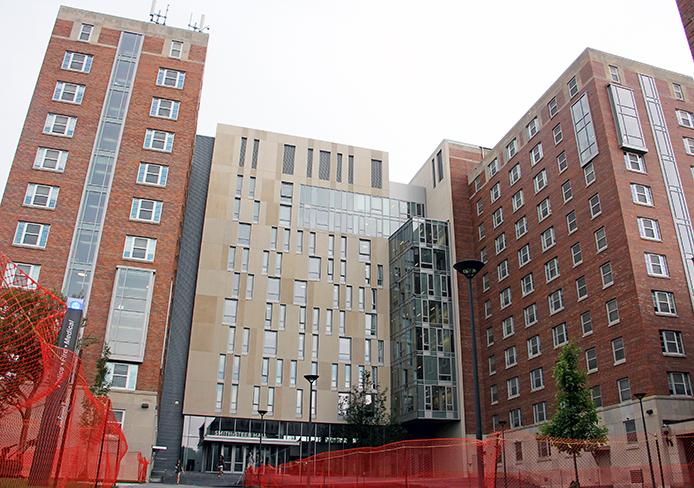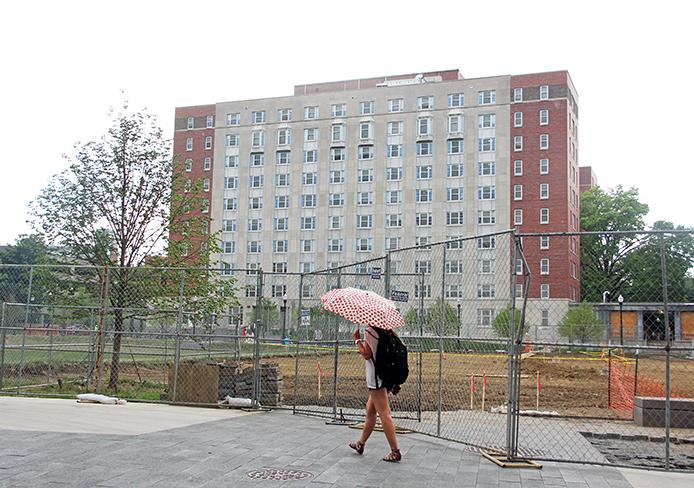
Smith and Steeb halls used to be separate dormitories but were combined. Credit: Ritika Shah / Asst. photo editor

Siebert hall opened this academic year as part of a $171M South renovation project. Credit: Ritika Shah / Asst. photo editor
After a year of renovations, Smith-Steeb and Siebert halls opened this academic year with a facelift.
Smith-Steeb and Siebert halls, built in the late 1950s, are home to a combined roughly 1,400 students, mostly freshmen. Before the renovation, there was a total of 1,096 beds in the three halls, according to The Lantern archives.
Just a few days into the school year, the dorms have been getting positive reviews from some of the residents.
“(My roommate and I) requested to live in one of the new dorms,” said Cori Smith, a first-year in exploration and Smith-Steeb Hall resident. “There is all brand-new furniture. It feels clean and modern.”
The halls were renovated as part of the $171 million South Campus High Rise Renovation and Addition Project, which also included the renovation of Park-Stradley Hall that opened last academic year.
Smith and Steeb halls were previously separate dormitories but were combined to house more than 1,000 students, and this academic year, three scholars programs are housed in it: Advocates for Children and Education, International Affairs and Politics, Society and Law scholars, as well as being home some of the general student population.
Meanwhile, Siebert Hall is home to about 300 first-year students and is one of two residence halls, where the other is Drackett Tower, that is strictly for first-years, Siebert residence hall director Spencer Giese said. The rooms are doubles and have community restrooms for same-gender hallways.
Both residence halls feature study, lounging, laundry and music rooms. Rooms are available for residents to rent for studying and group meetings, in addition to the large public space areas in every hallway, basement and lobby areas.
“We listened carefully to what students have told us,” Student Life spokesman Dave Isaacs said. “Residence halls have evolved and changed. It’s very up to date.”
Some students’ responses have been positive so far.
First-year in mechanical engineering Jake Barsala, also a Smith-Steeb Hall resident, said he enjoys the new kitchen and basement lounge area, which has a pool and ping-pong table.
The centralized location of the renovated dorms was a highlight for some residents.
“It’s very close to the Ohio Union and central to High Street,” said Anne Dietrich, a first-year studying health care and a Siebert Hall resident.
Barsala agreed.
“It’s a good location right by JO South and the Union,” Barsala said. “It’s near all the action.”
However, some students have concerns about the recently opened dorms. Barsala said he was worried about the safety of his valuables.
“There is (no storage) that locks,” Barsala said. “There are no (locked) drawers. My roommate has a safe and I’m going to buy one. I don’t want anyone to steal my stuff.”
With the new South Campus renovations, the university kept sustainability in mind, Isaacs said, by reusing the buildings and getting the heating and cooling from the geothermal wells under the South Oval.
“(Geothermal wells) promote (the) energy saving of 30 percent,” Isaacs said. “The design took energy efficiency by re-using and renovating the building.”
The halls will conserve water and have a heat recovery system, which captures heat and reuses it.
The South Oval has been closed since 2010 due to the installation of the geothermal wells. The project was completed this summer after ineffective drilling method delayed the project end date by more than a year.
Chesapeake Geosystems, Inc., the company initially under contract for the renovation, was released from its obligations because of its ineffective methods, according to The Lantern archives. The project originally cost $10.3 million and was expected to pay for itself in about ten years, but the budget jumped to $12 million due to the delays and was completed by Bergerson-Caswell.


